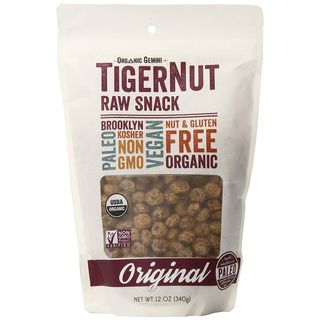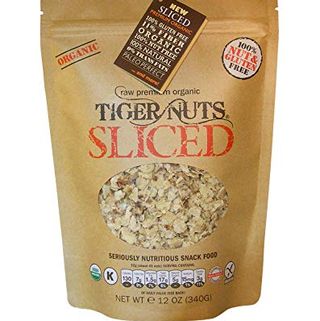Health Benefits of Tiger Nuts — 9 Ways to Eat and Drink Tigernuts

[ad_1]
Tiger nuts, one of the hottest superfoods on the market, are not, in fact, nuts. These wrinkled, marble-sized orbs are small, tuberous rhizomes of a sedge grass (cyperus esculentus lativum) that’s been cultivated for millennia around the world.
With a flavor reminiscent of both coconut and almond, they earn their name from a tiger-striped exterior. They can be eaten freshly dug out of the ground, or roasted, boiled, or juiced. Packaged tiger nuts have been dried to make them shelf-stable; they’re also sold as tiger nut flour and tiger nut milk. All come with numerous health benefits.
“Tiger nuts have been around for 4,000 years,” says Jack Sims, who launched America’s first tiger nut company, Supreme Peeled in 2013. He attributes their appeal to the fact that they were a vital component of our ancestors’ diets — plus the fact that the tiny tubers are high in fiber and low in calories and fat.
Jemma Claire, co-founder of UK-based wellness company Na’Vi Organics has been selling tiger nuts for almost three years. Claire notes that tiger nuts are also “high in magnesium, phosphorus, potassium, vitamins C and E,” and that some sources suggest they can help to reduce cellular aging through fighting damaging free radicals, to control blood pressure and promote a healthy digestive system. However, there is very few clinical trials about the effects of tiger nuts on humans, so more studies need to be conducted to make more solid conclusions.
What are the actual health benefits of tiger nuts?
What we do know: Tiger nuts are super high in resistant starch fiber, which has been getting a lot of buzz for its weight loss benefits, says Gina Consalvo, RD. Resistant starch passes through the stomach and small intestine without being digested, and may even help you lose weight by reducing blood sugar spikes and keeping you fuller longer than other foods with the same number of calories, she says. It also benefits your gut by acting as a prebiotic, stimulating the growth of good bacteria in the digestive tract.
“Since the gut acts as our immune system’s first line of defense, eating foods like tiger nuts that are loaded with resistant starch help our natural protective bacteria,” says Jaclyn London, MS, RD, CDN. “Since tiger nuts are so loaded with the stuff, you’re essentially set for the day just by consuming one serving.”
One ounce, or about 50 chickpea-sized pieces of plain, raw tiger nuts, contains 120 calories, 10 grams of fiber, 9 grams of naturally occurring sugars, tons of vitamins and minerals such as magnesium and iron, and 7 grams of fat, most of which is oleic acid, a monounsaturated fat that research shows can help reduce appetite and promote weight loss. For some context, a serving of almonds — about 23 nuts — has 163 calories and about a third of the filling fiber of tiger nuts.
Are there any downsides to tiger nuts?
People with digestive issues such as IBS or sensitivities to high-fiber foods might experience some gas, bloating, cramping, or diarrhea if you eat too many tiger nuts, says Consalvo. Raw tiger nuts are also higher in anti-nutrients like phytates, oxalates, saponins, and tannins that may reduce the amount of vitamins and minerals your gut can absorb. You can soak them, boil them, or toast them to increase their nutritional value if you’d like. Other than that, there aren’t many drawbacks.
Where can I buy tiger nuts?
Right now you can buy plain raw tiger nuts, tiger nut granola featuring various seeds and dried fruits, tiger nut flour to use in gluten-free baked goods, and unsweetened and sweetened tiger nut horchatas (a traditional drink in Spain made from water, ground tiger nuts, and a touch of sweetness from sugar or dates) at Whole Foods and online retailers.
And how should I eat them?
Ultimately, these delicious micro-powerhouses of wellness lend themselves to an abundance of applications. Here are nine ways to use them:
Whole Tiger Nuts
Of course, tiger nuts are delicious in their whole state, and I often eat them by the handful. Note: Depending on the brand you purchase, tiger nuts come either peeled or unpeeled, the peeled version being a bit softer and easier to eat. Think about the difference between the two as almonds that are blanched versus unbalanced. You can also soak tiger nuts for a few hours in order to soften them. I find after about four hours of soaking, the nuts inflate with water and take on the crunchy texture of a sunchoke.
Tiger Nut Milk
One of the first tiger nut recipes you’ll want to try is making a simple dairy-free milk. All you really need is a high-powered blender, and either cheesecloth or a nut milk bag. (Although you can always skip this step and buy pre-made milks, too.)
Try soaking your tiger nuts overnight and then blending them in a ratio of two cups of water to 1 cup of tiger nuts, along with half a vanilla bean. Using a nut milk bag, separate the milk from pulp. (Keep the pulp to repurpose as tiger nut flour; see below.)
Tiger Nut Chia Pudding
An easy way to introduce tiger nut milk into your diet is through breakfast cereal, oatmeal, or chia pudding. I love that tiger nuts add a subtle sweetness to dishes, and the milk is perfect as an early a.m. addition. Tiger nut milk is a great vehicle to rehydrate chia seeds, and once you mix the two, you can add any other flavors you like.
Tiger Nut Flour
You can take the leftover tiger nut pulp from making milk and repurpose that into a “flour” by dehydrating the pulp. From my experience in baking with tiger nut flour, it acts like almond flour, adding moisture and chewiness but with a bit more sweetness.
Pre-made tiger nut flours are also available online and at natural foods markets and Whole Foods.
Tiger Nut Cookies
Tiger nut flour is an excellent option for gluten-free bakers. As mentioned, it works similarly to almond flour with the added boost of a slight sweetness. Here’s a classic chocolate chip version, but you can get creative and add whatever flavors you like.
Tiger Nut Pancakes
One of the challenges I’ve found in making gluten-free pancake recipes is that unless your ratios are exact, pancakes without wheat flour either come out dense and leaden, or don’t have the flop of traditional pancakes and fall apart in the pan. However, I’ve found that tiger nut pancakes remain moist but not too heavy and the batter binds well. Feel free to jazz up the recipe with any baking spices you enjoy.
Tiger Nut Ice Cream
One of the downsides of non-dairy ice cream is that oftentimes the outcome is less creamy than one might expect. That’s because you’re not adding full-fat milk or egg yolks, ingredients which create traditional ice cream or gelato’s creaminess. But because tiger nuts are quite rich on their own, tiger nut milk yields a great ice cream base.
Tiger Nut Bread
Tiger nut flour is a great ingredient to added extra moisture and fiber to baked good both savory and sweet. While you can incorporate the tiger nut flour into tart shells, tiger nut flour also works well in breads, which gain their lightness from the addition of baking soda, while eggs bind the loaf together.
Tiger Nut Burgers
Some veggie burgers incorporate flour or other such ground grains to help bind the ingredients together. In place of wheat, tiger nuts serve as a gluten-free option when making a plant-based patty.
This content is created and maintained by a third party, and imported onto this page to help users provide their email addresses. You may be able to find more information about this and similar content at piano.io
[ad_2]
Source link












